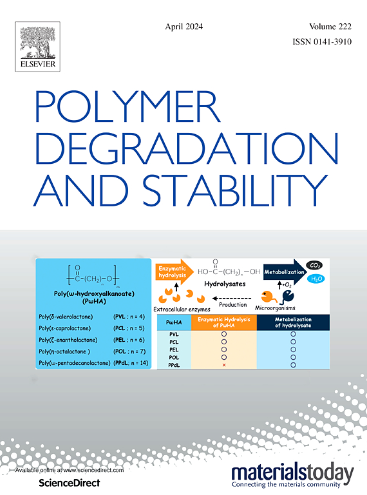以废聚对苯二甲酸乙二醇酯、苯基膦酸和新型缩水甘油酯为原料制备新型反应性阻燃涂料
IF 7.4
2区 化学
Q1 POLYMER SCIENCE
引用次数: 0
摘要
随着全球聚对苯二甲酸乙二醇酯(PET)的产量和消费量越来越高,废弃PET的数量也越来越多。研究了废旧PET的机械回收和化学回收等方法。在本报告中,我们选择了与己二酸酯交换反应的PET化学回收新方法,得到对苯二甲酸和低聚(己二酸乙酯-共对苯二甲酸乙酯)(OEAT)。对苯二甲酸也可以在酸或碱催化剂的存在下,在高温高压下水解从PET中回收,然后需要复杂的设备。酯交换反应相对于水解反应的优点是在常压下进行。OEAT含有脂肪族和芳族单位以及活性羧酸端基,有助于所制备的聚合物的柔韧性和热稳定性。经1H NMR表征,OEAT中己二酸酯和对苯二甲酸酯的摩尔百分比分别为59.4%和40.6%。研究了OEAT和苯基膦酸与新型缩水甘油醚单独或混合的反应。OEAT与苯基膦酸的结合提高了涂层的阻燃性。用FTIR对聚合物结构进行了表征,并用DSC-TGA对其热性能进行了表征。用简单二羧酸(己二酸)代替OEAT进行比较。固化后的涂层具有较高的凝胶含量、较高的弯曲极限应力、断裂应变和模量。但是这个样品的火焰测试失败了。因此,OEAT的芳香族对苯二甲酸酯单元和PPA的膦酸基团都有助于涂层的阻燃性。本文章由计算机程序翻译,如有差异,请以英文原文为准。

Novel reactive flame-retardant coating prepared from waste polyethylene terephthalate, phenylphosphonic acid, and novolac glycidyl ether
As global production and consumption of poly(ethylene terephthalate) (PET) becomes higher, so does the amount of waste PET. Several methods of waste PET reduction like mechanical and chemical recycling have been investigated. In this report, we selected the new chemical recycling of PET by transesterification reaction with adipic acid to regain terephthalic acid and oligo(ethylene-adipate-co-terephthalate) (OEAT). Terephthalic acid can also be recovered from PET by hydrolysis in the presence of acid or base catalysts at high temperature and pressure, then sophisticated equipment is required. The advantage of the transesterification over hydrolysis process is performing at atmospheric pressure. OEAT contains both aliphatic and aromatic units and reactive carboxylic acid end groups contributing to the flexibility and thermal stability of the prepared polymer. By 1H NMR characterization, the molar percentages of adipate and terephthalate units in OEAT were 59.4 % and 40.6 %, respectively. The reactions of OEAT and phenyl phosphonic acid with novolac glycidyl ether have been carefully investigated separately or as mixture. The combination of OEAT and phenyl phosphonic acid enhanced the flame retardancy of the obtained coating. Structures of the prepared polymers were confirmed by FTIR and their thermal properties were investigated by DSC-TGA. A simple dicarboxylic acid (adipic acid) was used in place of OEAT for comparison. The cured coating showed higher gel content, higher flexural ultimate stress, strain at break and modulus. However, the flame test of this sample failed. Consequently, both aromatic terephthalate units of OEAT and phosphonate group of PPA contribute to the flame retardancy of the coating.
求助全文
通过发布文献求助,成功后即可免费获取论文全文。
去求助
来源期刊

Polymer Degradation and Stability
化学-高分子科学
CiteScore
10.10
自引率
10.20%
发文量
325
审稿时长
23 days
期刊介绍:
Polymer Degradation and Stability deals with the degradation reactions and their control which are a major preoccupation of practitioners of the many and diverse aspects of modern polymer technology.
Deteriorative reactions occur during processing, when polymers are subjected to heat, oxygen and mechanical stress, and during the useful life of the materials when oxygen and sunlight are the most important degradative agencies. In more specialised applications, degradation may be induced by high energy radiation, ozone, atmospheric pollutants, mechanical stress, biological action, hydrolysis and many other influences. The mechanisms of these reactions and stabilisation processes must be understood if the technology and application of polymers are to continue to advance. The reporting of investigations of this kind is therefore a major function of this journal.
However there are also new developments in polymer technology in which degradation processes find positive applications. For example, photodegradable plastics are now available, the recycling of polymeric products will become increasingly important, degradation and combustion studies are involved in the definition of the fire hazards which are associated with polymeric materials and the microelectronics industry is vitally dependent upon polymer degradation in the manufacture of its circuitry. Polymer properties may also be improved by processes like curing and grafting, the chemistry of which can be closely related to that which causes physical deterioration in other circumstances.
 求助内容:
求助内容: 应助结果提醒方式:
应助结果提醒方式:


